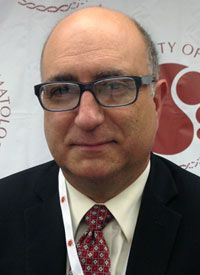Autologous Transplantation Effective, Safe for HIV-Associated Lymphoma
Patients with HIV-associated lymphoma can effectively be treated with autologous hematopoietic stem cell transplantation (AHCT), with outcomes that are similar to patients without HIV. Joseph Alvarnas, MD, presented results from a phase II study at the 2014 ASH Annual Meeting.
Joseph Alvarnas, MD, the director of Medical Quality at City of Hope National Medical Center

Patients with HIV-associated lymphoma can effectively be treated with autologous hematopoietic stem cell transplantation (AHCT), with outcomes that are similar to patients without HIV. Joseph Alvarnas, MD, presented results from a phase II study at the 2014 ASH Annual Meeting.
"These patients could in fact undergo transplant. The 1-year overall survival was our proposed primary outcome. For this group of patients, it was 86.6%," said Alvarnas, the director of Medical Quality at City of Hope National Medical Center in Duarte, California, in an interview withTargeted Oncology. "We actually compared our patients to 151 age- and disease-status matched controls without HIV infections. What we found was that the outcomes for our patients were superimposable and were not statistically significantly different from that group."
Patients with HIV are 25 times more likely to develop lymphoma compared with patients without the infection. Despite this higher risk, a treatment for these individuals lags behind the general population. In fact, in many situations HIV-positivity is an exclusion criterion for clinical trials exploring AHCT.
"The tendency is to undertreat patients with HIV infections and lymphoma. I think the bottom line is that we should approach these patients in a way that is comparable to those without HIV infections," Alvarnas said. "If they would otherwise be candidates for autologous transplant and have treatable HIV infections, then move them on to transplant as you would with someone without the infection."
The phase II trial enrolled 43 patients with treatable HIV-1 infection and chemotherapy-sensitive relapsed/refractory aggressive lymphoma. Overall, 40 patients underwent AHCT along with the modified preparative BEAM regimen (carmustine 300 mg/m2on day 6, etoposide 100 mg/m2twice daily on days 5 to 2, cytarabine 100 mg/m2on days 5 to 2, and melphalan 140 mg/m2on day 1).
Patients enrolled in the trial had diffuse large B-cell lymphoma (40%), Hodgkin lymphoma (37.5%), Burkitt/Burkitt-like lymphoma (17.5%), and plasmablastic lymphoma (5%), and were a median 46.9 years old and had adequate organ function. Patients received standard supportive care; highly active antiretroviral therapy was withheld during the preparative regimen and until therapy-related GI toxicity was resolved.
Prior to entering the trial, 30 patients (75%) were in complete remission (CR) and 31 patients (77.5%) had undetectable HIV viral loads. The median viral load was 84 copies/mL and median CD4 count was 250.5/µL.
After a median follow-up of 24 months, the 1-year overall survival (OS) rate was 86.6% (95% CI, 70.8-94.2) and the progression-free survival rate was 82.3% (95% CI, 66.3-91.1). At 1-year post transplant, 12.5% of patients had progressed or relapsed.
One hundred days posttransplant, one patient had experienced an early death and 39 were evaluated for disease response. CRs were detected in 92.3% of patients and 2.6% had partial responses. At 12 months, three patients had died from recurrent/persistent disease.
For comparison, 151 control patients who matched patients on the trial for age, performance score, disease, and disease stage were selected from the Center for International Blood and Marrow Transplant Research database. In control patients, the 1-year OS rate was 87.7% compared with 86.6% for patients with HIV (HR = 0.79;P= .56).
Thirteen patients experienced grade 3 side effects and two patients experienced a grade 4 side effect. Within the year following transplant, 42.5% of patients developed infection, including severe infections in nine patients (22.5%). Median time to neutrophil engraftment was 11 days and the median time to platelet transfusion-independent engraftment >20,000/µl was 18 days.
"What was striking about the trial, in terms of treatment-related mortality, toxicity, infection rate, there was not an increase above what we would expect," Alvarnas noted. "One of the fears is that you would either see an emergence of opportunistic infections, and that certainly didn't happen either. The overall mortality in our trial was 5%, which is comparable to what you would see nationwide for this type of transplant."
Alvarnas J, Le-Rademacher J, Wang Y, et al. Autologous hematopoietic stem cell transplantation (AHCT) in patients with chemotherapy-sensitive, relapsed/refractory (CSRR) human immunodeficiency virus (HIV)-associated lymphoma (HAL): results from the Blood and Marrow Transplant Clinical Trials Network (BMT CTN 0803)/AIDS Malignancy Consortium (AMC-071) Trial. Paper presented at: 2014 ASH Annual Meeting; December 6-9, 2014; San Francisco, CA. Abstract 674.
Peers Discuss Role of Pola-R-CHP vs R-CHOP in Newly Diagnosed DLBCL
April 19th 2024During a Case-Based Roundtable® event, Haifaa Abdulhaq, MD discussed with participants whether the POLARIX trial influences their choice to use the pola-R-CHP as opposed to R-CHOP regimen for patients with newly diagnosed diffuse large B-cell lymphoma.
Read More
Examining the Non-Hodgkin Lymphoma Treatment Paradigm
July 15th 2022In season 3, episode 6 of Targeted Talks, Yazan Samhouri, MD, discusses the exciting new agents for the treatment of non-Hodgkin lymphoma, the clinical trials that support their use, and hopes for the future of treatment.
Listen
PTCy Offers New Hope for Mismatched Stem Cell Transplants in Leukemia, MDS
April 13th 2024Jeff Auletta, MD, discussed how PTCy-based graft-vs-host disease prophylaxis offers a promising approach for expanding access to successful cell transplantation regardless of donor match or patient ethnicity.
Read More